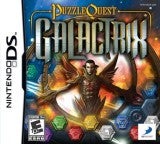Allowing yourself to get really into Puzzle Quest is akin to what it might be like to endure a long-term gambling addiction without the fleeting promise of the big payout. In other words, like hitching your fate to brutal probability with the best-case scenario being that you simply get to keep playing. This, mind you, is coming from someone who's clocked upwards of 80 hours into the original Puzzle Quest. Yes, Puzzle Quest is essentially what you get when you take out the invisible dice that operate most RPGs and replace them with a Bejeweled board. But there's just something about its Lite-Brite aesthetics that evoke the trashy compulsiveness of video poker much more than, say, the austerity of Wizardry.
And yet I keep playing.
More than that, actually -- on quite a number of occasions following a visit from publisher D3 earlier this week, I've found myself daydreaming about Puzzle Quest: Galactrix. Yes, it's more of the same. Much more: it's bigger, bad-ass-er, and (even better) in space. But the distant promise of its Q1 '09 release has brought into focus just how neatly the first Puzzle Quest fit into my nightly routine. As a lapsed WoW player, I was in dire need of something to do for an hour or so between 11:00 p.m. and bedtime. Something, preferably, that didn't require my full attention, so as to allow me to also listen to a podcast or something. When it got to the point that I could no longer stomach honor grinds and daily quest slogs to wrap up my evenings, Puzzle Quest became the crucial intermediary. Sneer at myself as I might have for having fallen prey to "Bejeweled with orcs," I eventually accepted that the game served me admirably. I finally understood "casual gaming," though I'm hesitant to write off Puzzle Quest as such. The way I use it, it's probably more like productivity software.
Space Physics
The most meaningful change in Galactrix is how the board operates. You're still lining up gems of the same color (hexagonal ones, now), but in a move meant to reflect the spatial properties of the vastness of space, the way that the board refreshes has changed. No longer will gems arbitrarily drop from above: They'll actually issue forth from the direction that the gem that triggered the match moved. When you consider that each "gem" will have six matchable sides, the potential for insane probability-enabled chain reactions becomes clear. Puzzle Quest vets might be surprised to learn that matching four gems no longer triggers an extra turn; given the increased capability for matching colors to touch on the new board, four-matches were apparently too common of an occurrence. In Galactrix, you have to match five in order to get another go.
In Search of: Mana
In Galactrix's world, the light of scientific progress has apparently allowed humanity to shuffle off superstitious notions of renewable magical energy. But that doesn't mean you won't be matching gems to make meters get bigger, and power special attacks. The different gem colors in Galactrix correspond to your ship's different systems: weapons, energy, and computers. Upgrades to your ship take the place of spells: they deplete your stores of different-color energies when used, and many have reuse timers and such. Matching blue gems will replenish your ship's shields (think of them like "Wall of Fire" spells that everyone gets by default), and white gems give you an intel boost, which is essentially experience for your pilot. Purple gems, meanwhile, net you psionics, whose functions weren't quite made clear during the demo earlier this week. Mines, finally, take the place of skulls, and matching three or more will do damage to your opponent.





